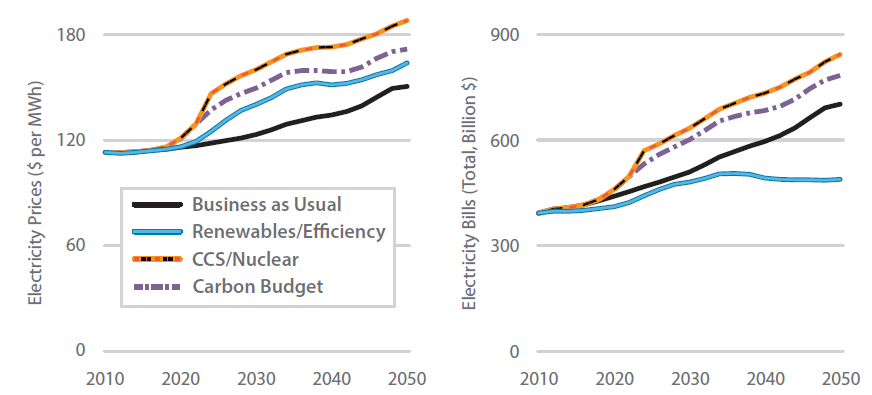Contrary to the public assertions made this week by some of our climate scientist friends, nuclear power is likely to have a limited near-term role in avoiding the worst impacts of climate change. Renewable energy technologies are cheaper, less risky, and ready for deployment today. A look at where things stand with both nuclear and renewables bears all that out.
Earlier this week, climate scientists James Hansen, Ken Caldeira, Kerry Emanuel, and Tom Wigley, sent a letter “to those influencing environmental policy but opposed to nuclear power,” calling for the expansion of nuclear power to fight global warming. They also claim that renewable energy sources cannot be scaled up fast enough to address the problem. While we have tremendous respect for these scientists and their research on climate change, we will have to agree to disagree on this issue.
Nuclear power is not a near-term climate solution
UCS does not take a position for or against nuclear power, but has worked for more than 40 years as a nuclear power safety watchdog. Because the need to reduce global warming emissions is so large and urgent, we don’t want to take nuclear power off the table as a potential long-term climate solution. However, our position is that for an expansion of nuclear power to be considered an option, it must be safer and more secure than it is now and the Nuclear Regulatory Commission must become a more effective regulator. (For more details, see this 2007 report).
In the letter, the scientists point toward new technologies and designs to solve some of the current problems with nuclear power. However, as UCS nuclear power safety experts have described elsewhere, new technologies such as Small Modular Reactors and Integral Fast Reactors, have not been proven and are therefore not available for near-term expansion.
It typically takes 10 or more years to get a new nuclear plant permitted and built in the U.S. In contrast, more modular technologies like wind and solar can be permitted and built in 2 years or less.
Nuclear power is too expensive
Building new nuclear plants is a much more expensive way to reduce emissions than many renewable energy technologies and other low carbon alternatives, as shown in two recent UCS reports:
- Our Water-Smart Power report shows that increasing nuclear power and coal with carbon capture and storage to meet U.S. carbon emission reduction targets would significantly increase consumer electricity bills, while a high efficiency and renewable energy scenario would save consumers money and dramatically lower water use (see Figure).

- In a 2012 report, we showed that the Vogtle nuclear plant, which is currently under construction in Georgia, and the proposed Levy nuclear plant in Florida, would be more expensive than energy efficiency, natural gas, and many renewable energy technologies (see Figure). This was the case even when $6 billion in federal loan guarantees were included for Vogtle. Since we released the report, the cost of Vogtle has escalated by over $1.6 billion, and the total cost of Levy escalated to $24 billion and was ultimately cancelled.

The cost of renewable energy is falling
While the cost of new nuclear plants has been escalating, the costs of wind and solar have been falling. As discussed in my recent blog, project data from the U.S. Department of Energy shows that average U.S. prices for wind power dropped 43 percent between 2009 and 2012. The average installed cost of solar photovoltaic (PV) systems has also fallen about 60 percent since 2009, according to a Solar Energy Industries Association report.

Renewables are being deployed at record levels
U.S. wind power capacity more than tripled in the U.S. between 2007 and 2012, while U.S. solar photovoltaic (PV) capacity expanded by a factor of five over the past three years, as we showed in our Ramping up Renewables report. Both technologies broke records in 2012, with over 13 GW of wind and 3.2 GW of solar PV representing more than half of all new generating capacity installed in the U.S. In contrast, the 5.5 GW of new nuclear capacity that is currently planned or under construction in the U.S. will be mostly offset by the 4 GW of existing nuclear capacity that was announced for closure this year at four U.S. plants.
Many states and countries are already achieving higher levels of renewable electricity than many thought possible just a few years ago. For example:
- Nine states generated more than 10 percent of their electricity from wind power in 2012, with Iowa and South Dakota leading the pack at 24 percent.
- Xcel Energy recently broke a U.S. record in Colorado for generating 60 percent of its electricity from wind during an hour when the winds were strong and electricity demand was low.
Numerous studies by the government agencies, utilities, and regional grid operators show we can achieve much higher levels of renewable penetration, while maintaining a reliable and affordable electricity supply. For example:
- A 2012 National Renewable Electricity Laboratory study shows that renewable energy can provide 80 percent of U.S. electricity generation by 2050, using technologies that are commercially available today, while meeting electricity demand in every hour of the year in every region of the country. It also reduced power plant carbon emissions by 80 percent.
- A new study by PJM — the grid operator in the Mid-Atlantic states — found that wind and solar could supply 30 percent of the region’s electricity by 2026, as described in this UCS blog.
Before calling for a nuclear renaissance to address climate change, let’s take a closer look at the facts. While nuclear power should not be taken off the table as a long-term climate solution, it is still too expensive and risky to play a significant role in the near-term. In contrast, renewable energy is already delivering significant emission reductions and is poised to play a much greater role.
